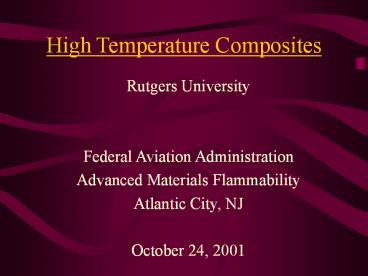High Temperature Composites - PowerPoint PPT Presentation
Title:
High Temperature Composites
Description:
Mechanical properties of carbon and glass composites. Hybrid composites: carbon/glass and ... Strain at peak load (ductility) Density. All glass: 2.36 g/cm3 ... – PowerPoint PPT presentation
Number of Views:451
Avg rating:3.0/5.0
Title: High Temperature Composites
1
High Temperature Composites
- Rutgers University
- Federal Aviation Administration
- Advanced Materials Flammability
- Atlantic City, NJ
- October 24, 2001
2
Research Team
- P. Balaguru
- J. Giancaspro
- C. Papakonstantinou
- R. Lyon (FAA)
3
Introduction
- Polysialate (Geopolymer)
- Aluminosilicate
- Water-based, non-toxic, durable
- Resists temperatures up to 1000C
- Curing temperature 20, 80, 150C
- Protects carbon from oxidation
4
Ongoing Research at Rutgers
- Mechanical properties of carbon and glass
composites - Hybrid composites carbon/glass and
inorganic/organic - Structural sandwich panels
- Comparison with other high temperature composites
5
Hybrids Fiber Characteristics
- Glass Economical, larger fiber diameter
- Carbon Higher modulus and strength, durability
6
Variables
- Eglass fiber core with carbon fiber skins
- Number of layers on tension side 1,2,3
- Type of carbon fabric 1k and 3k woven, 3k
unidirectional - Number of layers on the compression side 1,2,3
- Specimen thickness 6, 12, and 18 layers of
glass fabrics
7
Specimen Preparation
- Hand impregnation
- Room temperature (20C) curing
- 1 MPa of pressure for 24 hours
- Post curing for 3 weeks
- Room temp. curing reduces degradation of glass
under alkali environment
8
Test Setup
- Simply supported
- 3-point bending (ASTM D790)
- Loading rate 2.5 mm / min
9
Mechanical Properties
- Load deflection response converted to stress
and strain - Stress,
- Strain,
10
Assumptions for Analysis
- Homogeneous
- Elastic
- Uncracked section
- Perfect bond between glass and carbon layers
11
Glass / Carbon Hybrid Results
- Density
- Failure pattern
- Peak stress (strength)
- Strain at peak load (ductility)
12
Density
- All glass 2.36 g/cm3
- All carbon 1.9 to 2.0 g/cm3 for 3 types
- Increase in carbon layers provide consistent
decrease in density
13
Failure Pattern
- Glass brittle, no post-cracking strength
- Glass with 1 and 2 carbon layers failed in
tension - Glass with 3 carbon layers compression failure
- Glass with both tension and compression
reinforcement compression failure
14
(No Transcript)
15
3k Unidirectional Carbon
16
Samples with 2 Carbon Layers
17
Varying Sample Thickness
18
Maximum Stress 3k Uni Carbon
- Pure Glass 103 MPa
- Glass 1 Layer 212 MPa
- Glass 2 Layers 379 MPa
- Glass 3 Layers 354 MPa
- 3k Unidirectional Carbon 466 MPa
19
Thickness vs. Maximum Stress
- 6 Glass 1 carbon (uni) 347 MPa
- 12 Glass 2 carbon 379 MPa
- 18 Glass 3 carbon 362 MPa
20
Maximum Strains
- Matrix (tension) 0.0007
- Matrix (compression) 0.005
- All Glass (tension) 0.003
21
Maximum Strain 3k Uni Carbon
- Pure Glass 0.003
- Glass 1 Layer 0.007
- Glass 2 Layers 0.011
- Glass 3 Layers 0.009
- 3k Uni Carbon 0.005
22
Thickness vs. Maximum Strain
- 6 Glass 1 carbon (uni) 0.012
- 12 Glass 2 carbon 0.011
- 18 Glass 3 carbon 0.011
23
Conclusions Glass/Carbon Hybrids
- Eglass / carbon is a viable combination.
- For all types of carbon fabric, 2 layers on the
tension side provides the highest strength. - Placing carbon on both compression and tension
faces does not significantly increase the
strength.
24
Conclusions Glass/Carbon Hybrids
- Eglass reinforced with 1, 2, or 3 carbon layers
exhibited the highest strength when the fabric
was 3k unidirectional - Slightly lower strengths were achieved using 3k
woven carbon fabric - The lowest strengths were achieved using 1k woven
carbon fabric
25
Conclusions Glass/Carbon Hybrids
- The uncracked section modulus for Eglass
reinforced with 1k or 3k woven on the tension
side showed little change as the number of carbon
layers increased. - 3k unidirectional carbon on the tension side
provided a modulus increase with an increasing
number of layers. - An increase in modulus also results for carbon on
both compression and tension sides.
26
Strain Capacity of Polysialates
- Cantilever Beam Method
27
Variables Investigated
- Silica / Alumina ratio
- Discrete carbon fiber content
- Effect of ceramic micro-fibers
28
Influence of Carbon Fiber Content on Cracking
Strain
29
Effect of Microfibers
Without Ceramic Microfibers
With Ceramic Mircofibers
30
Durability
- Wet-Dry
- Flexure
- 45 In-Plane Shear
- Thermo-mechanical
- Exposure Temperatures (200, 400, 500, 600C)
31
Wet Dry Durability
32
Comparison of Polysialate and Other Inorganic
Composites
- Relative performance of polysialate composites
- Processing requirements
- Mechanical properties
- Carbon/Carbon composites
- Ceramic matrix composites
- Carbon/Polysialate composites
33
Stress vs. Strain Relationships of Bi-directional
Composites in Tension
34
Tensile Strength of Bi-directional Composites
35
Flexural Strength of Unidirectional Composites
36
Flexural Stress-Strain Relationships of
Unidirectional Composites
37
Flexural Strength of Bi-directional Composites
38
Lightweight Sandwich Panels
- Core features
- - Inorganic matrix ceramic spheres
- - Density 0.6 to 0.7 g/cm3
- - Compressive strength 5.12 MPa
- Carbon fabric laminated onto facings
39
Typical Section of Sandwich Slab (Panel)
- Lightweight ceramic core
- Carbon facings on both tension and compression
sides
40
Flexural Strength of Slabs With Different
Reinforcement
41
Load vs. Deflection for Slabs
42
Future Research
- Commercially available plates Inorganic
matrix layer - Glass plates
- Carbon plates
- Fatigue
- Sandwich panels































